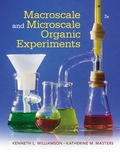
EBK MACROSCALE AND MICROSCALE ORGANIC E
7th Edition
ISBN: 8220101437488
Author: Williamson
Publisher: YUZU
expand_more
expand_more
format_list_bulleted
Concept explainers
Textbook Question
Chapter 8, Problem 6Q
Arrange the following in order of increasing
Expert Solution & Answer
Trending nowThis is a popular solution!

Students have asked these similar questions
None
Q1: For each molecule, assign each stereocenter as R or S. Circle the meso compounds. Label
each compound as chiral or achiral.
+
CI
Br
:
Н
OH
H
wo་ཡིག་ཐrow
HO
3
D
။။ဂ
CI
Br
H,
CI
Br
Br H₂N
OMe
R
IN
I
I
N
S
H
Br
ជ័យ
CI
CI
D
OH
Please correct answer and don't use hand rating
Chapter 8 Solutions
EBK MACROSCALE AND MICROSCALE ORGANIC E
Ch. 8 - Prob. 1QCh. 8 - Prob. 2QCh. 8 - What problem will ensue if the level of the...Ch. 8 - Prob. 4QCh. 8 - Prob. 5QCh. 8 - Arrange the following in order of increasing Rf...Ch. 8 - What will be the result of applying too much...Ch. 8 - Prob. 8QCh. 8 - Prob. 9QCh. 8 - A TLC plate showed two spots with Rf values of...
Knowledge Booster
Learn more about
Need a deep-dive on the concept behind this application? Look no further. Learn more about this topic, chemistry and related others by exploring similar questions and additional content below.Similar questions
- Nonearrow_forward%Reflectance 95 90- 85 22 00 89 60 55 50 70 65 75 80 50- 45 40 WA 35 30- 25 20- 4000 3500 Date: Thu Feb 06 17:21:21 2025 (GMT-05:0(UnknownD Scans: 8 Resolution: 2.000 3000 2500 Wavenumbers (cm-1) 100- 2981.77 1734.25 2000 1500 1000 1372.09 1108.01 2359.09 1469.82 1181.94 1145.20 1017.01 958.45 886.97 820.49 668.25 630.05 611.37arrow_forwardNonearrow_forward
- CH3 CH H3C CH3 H OH H3C- -OCH2CH3 H3C H -OCH3 For each of the above compounds, do the following: 1. List the wave numbers of all the IR bands in the 1350-4000 cm-1 region. For each one, state what bond or group it represents. 2. Label equivalent sets of protons with lower-case letters. Then, for each 1H NMR signal, give the 8 value, the type of splitting (singlet, doublet etc.), and the number protons it represents. of letter δ value splitting # of protons 3. Redraw the compound and label equivalent sets of carbons with lower-case letters. Then for each set of carbons give the 5 value and # of carbons it represents. letter δ value # of carbonsarrow_forwardDraw the correct ionic form(s) of arginine at the pKa and PI in your titration curve. Use your titration curve to help you determine which form(s) to draw out.arrow_forwardPlease correct answer and don't use hand ratingarrow_forward
- Nonearrow_forwardNonearrow_forwardCarbohydrates- Draw out the Hawthorne structure for a sugar from the list given in class. Make sure to write out all atoms except for carbons within the ring. Make sure that groups off the carbons in the ring are in the correct orientation above or below the plane. Make sure that bonds are in the correct orientation. Include the full name of the sugar. You can draw out your curve within the text box or upload a drawing below.arrow_forward
- How many milliliters of 97.5(±0.5) wt% H2SO4 with a density of 1.84(±0.01) g/mL will you need to prepare 2.000 L of 0.110 M H2SO4? If the uncertainty in delivering H2SO4 is ±0.01 mL, calculate the absolute uncertainty in the molarity (0.110 M). Assume there is negligible uncertainty in the formula mass of H2SO4 and in the final volume (2.000 L) and assume random error.arrow_forwardDon't used hand raiting and don't used Ai solutionarrow_forwardWhat should be use to complete the reaction? CN CNarrow_forward
arrow_back_ios
SEE MORE QUESTIONS
arrow_forward_ios
Recommended textbooks for you
 Chemistry: The Molecular ScienceChemistryISBN:9781285199047Author:John W. Moore, Conrad L. StanitskiPublisher:Cengage Learning
Chemistry: The Molecular ScienceChemistryISBN:9781285199047Author:John W. Moore, Conrad L. StanitskiPublisher:Cengage Learning

Chemistry: The Molecular Science
Chemistry
ISBN:9781285199047
Author:John W. Moore, Conrad L. Stanitski
Publisher:Cengage Learning
IR Spectroscopy; Author: Professor Dave Explains;https://www.youtube.com/watch?v=_TmevMf-Zgs;License: Standard YouTube License, CC-BY